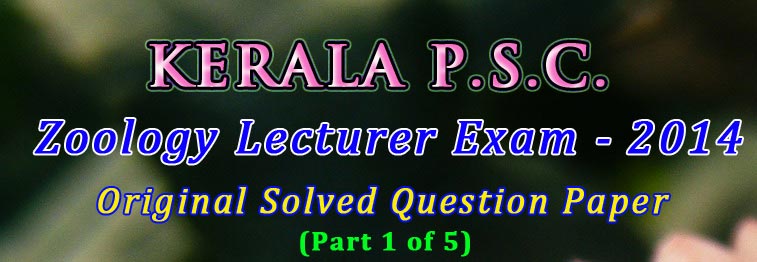
Kerala PSC Zoology Lecturer / Assistant Professor Recruitment Exam 2014
Question Paper (Q. Code 56/2014)
Original solved question paper of Kerala PSC Zoology Lecturer/Assistant Professor examination conducted by Kerala PSC (Kerala Public Service Commission) on 29/04/2014 (Question Paper Code 56/2014) for the appointment of Zoology Lecturer/Assistant Professor in Government Colleges of Kerala under the Directorate of Collegiate Education, Trivandrum, Kerala. Questions are in MCQ (Multiple Choice Questions) format.
Part – 1 of 5 (Questions 1 – 20)
1. The naturalist who independently conceived the idea of Natural Selection along with Darwin:
a. Alfred Russell Wallace
b. Charles Lyell
c. Joseph Hooker
d. John Henslow
Ans. (a)
2. The theory proposed by Stephen Jay Gould and Niles Eldredge to explain Evolution:
a. Theory of Genetic drift
b. Theory of punctured equilibrium
c. Theory of genetic equilibrium
d. Theory of Orthogenesis
Ans. (b)
3. A system of classification based on the phylogenetic relationships and evolutionary history of groups of organisms:
a. Phenetics
b. Phyletics
c. Cladistics
d. Phylogenetics
Ans. (c)
4. Eight kingdom classification was proposed by:
a. R.H. Whittaker
b. Carl Woese
c. Carlous Linnaeus
d. Cavalier Smith
Ans. (d)
5. Protein that was used to create the first phylogenetic tree based on molecular data:
a. Cytochrome A
b. Cytochrome B
c. Cytochrome C
d. Cytochrome D
Ans. (c)
6. Malaise traps are used to collect:
a. Birds
b. Insects
c. Mammals
d. Plankton
Ans. (b)
7. The loss of genetic variation that occurs when a new population is established by a very small number of individuals form a larger population is known as:
a. Genetic stability principle
b. Hardy Weinberg Principle
c. Speciation Principle
d. Founder Principle
Ans. (d)
8. An example for co-evolution is:
a. Evolution of bees and flowers they pollinate
b. Evolution of horse and deer
c. Evolution of marsupials and placental mammals
d. Evolution of man and ape
Ans. (a)
9. The technique that uses rates of molecular changes to study phylogenetic relationship is:
a. Molecular taxonomy
b. Molecular clock
c. Molecular genetics
d. Molecular phylogeny
Ans. (b)
10. When the name of a species or sub-species is the repetition of the generic name (example: Apis apis apis) it is known as____.
a. Homonym
b. Heteronym
c. Synonym
d. Tautonym
Ans. (d)
11. Cyclic AMP is the second messenger of:
a. Testosterone
b. Catecholamine
c. Progesterone
d. Insulin
Ans. (b)
12. The enzyme that convert Dihydroxy acetone phosphate to D-glyceraldehyde-3 phosphate is:
a. Glyceraldehyde 3 phosphate dehydrogenase
b. Enoyl coenzyme A hydratase
c. Glycerol kinase
d. Triose phosphate isomerase
Ans. (d)
13. Normal value of glomerular filtration rate is:
a. 10 ml/minute
b. 525 ml/minute
c. 125 ml/minute
d. 750 ml/minute
Ans. (c)
14. Gastric inhibitory peptide is secreted by:
a. G cells of the stomach
b. L cells of the duodenum and jejunum
c. Alpha cells of Pancreatic islands
d. K cells of duodenum and jejunum
Ans. (d)
15. At high concentration of substrate an uncompetitive inhibitor:
a. Lowers Vmax and Km
b. Increase Vmax and Km
c. Lowers Vmax and increase Km
d. Increase Vmax and Km get unaltered
Ans. (a)
16. Diabetes insipidus is caused by the absence of the secretion of:
a. Insulin
b. Gastrin
c. Antidiuretic hormone
d. Estrogen
Ans. (c)
17. Depolarization of SA node is mainly due to:
a. Influx of calcium ions
b. Influx of magnesium ions
c. Efflux of calcium ions
d. Efflux of magnesium ions
Ans. (a)
18. Precursor for catecholamine hormone is:
a. Methionine
b. Alanine
c. Tyrosine
d. Serine
Ans. (c)
19. Chitin is:
a. Hetero-polysaccharide with glucuronic acid and N acetyl glucosamine residues linked by β1 – 4 linkage
b. Homo-polysaccharide with D glucose residues linked by β1 – 4 linkage
c. Homo-polysaccharide of D fructose residues linked by β1 – 2 linkage
d. Homo-polysaccharide with N acetyl glucosamine residues liked by β1- 4 linkage
Ans. (d)
Learn more: MCQ on Carbohydrates: Part 1 | Part 2 | Part 3 |
20. Human ABO blood group is determined by:
a. Antigenic property of lecithin of the membrane
b. Antigenic property of oligosaccharide head group of glycosphingolipid
c. Antigenic properties of ethanolamines
d. Antigenic properties of cholesterol of the membrane lipid
Ans. (b)
Learn more: Membrane Lipids- Properties, Structure and Classification
Learn more: MCQ on Plasma Membrane
Kerala PSC Zoology Lecturer 2014 Exam
| Part 1/5 | Part 2/5 | Part 3/5 | Part 4/5 | Part 5/5 |
